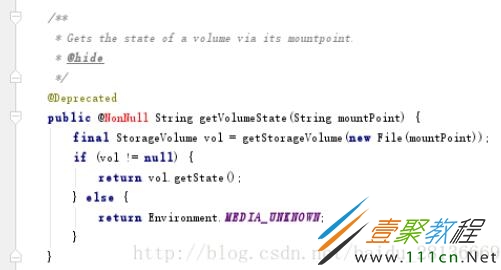Android获得所有存储设备位置的最佳方法
作者:袖梨
2022-06-25
本方式可以获得内部存储设备地址、SD卡地址、USB设备地址,兼容性能达到99%(别问我为什么这么保证,因为是借鉴了Android设置->存储页面的源码)。
由于调用了几个被@hide的方法,所以采用了反射。
具体代码如下:
public static ListgetAllExternalStorage(Context context) { List storagePath = new ArrayList<>(); StorageManager storageManager = (StorageManager) context.getSystemService(STORAGE_SERVICE); StorageVolume[] storageVolumes; try { Method getVolumeList = StorageManager.class.getDeclaredMethod("getVolumeList"); storageVolumes = (StorageVolume[]) getVolumeList.invoke(storageManager); Method getVolumeState = StorageManager.class.getDeclaredMethod("getVolumeState", String.class); for (StorageVolume storageVolume : storageVolumes) { String desc = storageVolume.getDescription(context); Log.i(TAG, "storageVolume name--->" + desc); Method getPath = StorageVolume.class.getMethod("getPath"); String path = (String) getPath.invoke(storageVolume); Log.i(TAG, "StoragePath--->" + path); //这里需要用StorageManager反射调用getVolumeState函数,而不应该用StorageVolume的getState方法,因为可能会报错 String state = (String) getVolumeState.invoke(storageManager, path); Log.i(TAG, "storageVolume State--->" + state); if (Environment.MEDIA_MOUNTED.equals(state)) { HomeDirBean bean = new HomeDirBean(path, desc); storagePath.add(bean); } } } catch (Exception e) { Log.e(TAG, e.getMessage()); } return storagePath; }
这里需要注意,可能有小伙伴会问,既然StorageVolume类有getState方法,为啥还要用StorageManager反射调用getVolumeState方法,并传入path地址,而在源码里,StorageManager的getVolumeState的方法的实现,也是将path重新创建为StorageVolume类,然后再调用其getState方法,我们这样做成这不是多此一举吗?
源码截图如下:
答案当然不是了,不然我也不会放弃性能去反射那个方法去装这个逼了。主要原因是@hide的这个方法里,mountPoint被重新打包成StorageVolume时,这相当于系统去创建的一个StorageVolume实例,自然可以执行它的所有方法。而如果是应用直接调用,在被打包时,很多方法被隐藏了,比如这个getState方法,这时候应用就会报错,找不到该方法。
先简单写到这,以后有补充再添加。
相关文章
精彩推荐
-
 下载
下载孢子2生物进化中文版(Spores)
模拟经营 孢子2生物进化中文版(Spores)孢子2生物进化中文版让我们来做一回疯狂的博士,打造一个属于自
-
 下载
下载叫我万岁爷九游官方版
模拟经营 叫我万岁爷九游官方版叫我万岁爷带你体验当换地点感觉,全新的模拟手游大作让你开始一
-
 下载
下载梦回凤歌
模拟经营 梦回凤歌梦回凤歌手游中你将步入古代的宫廷纷争之中,本想度过美好幸福的
-
 下载
下载洋果子店rose最新版本
模拟经营 洋果子店rose最新版本洋果子店最新版是一款十分容易让人垂涎的开店经营类手游。游戏玩
-
 下载
下载明日大亨最新版
模拟经营 明日大亨最新版明日大亨手游,一个非常经典有趣的模拟经营类型的商战手游,在游
















